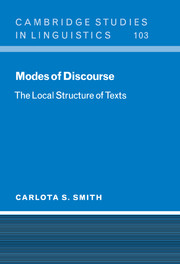Book contents
- Frontmatter
- Contents
- Preface
- Introduction
- PART I DISCOURSE STRUCTURE
- PART II LINGUISTIC ANALYSIS OF THE DISCOURSE MODES
- PART III SURFACE PRESENTATIONAL FACTORS
- 7 Subjectivity in texts
- 8 The contribution of surface presentation
- 9 Non-canonical structures and presentation
- PART IV DISCOURSE MODES AND THEIR CONTEXT
- Appendix A The Texts
- Appendix B Glossary
- References
- General index
- Index of names
8 - The contribution of surface presentation
Published online by Cambridge University Press: 18 June 2010
- Frontmatter
- Contents
- Preface
- Introduction
- PART I DISCOURSE STRUCTURE
- PART II LINGUISTIC ANALYSIS OF THE DISCOURSE MODES
- PART III SURFACE PRESENTATIONAL FACTORS
- 7 Subjectivity in texts
- 8 The contribution of surface presentation
- 9 Non-canonical structures and presentation
- PART IV DISCOURSE MODES AND THEIR CONTEXT
- Appendix A The Texts
- Appendix B Glossary
- References
- General index
- Index of names
Summary
Sentences that differ in arrangement and sentence accent also differ in meaning, although their propositional content may be the same. As Bolinger puts it, discussing the difference between active and passive (1977:9):
The classical case is the passive voice. If truth value were the only criterion, we would have to say that John ate the spinach and The spinach was eaten by John are the same. They report the same event in the real world. The same entities are present, in the same relationship … Linguistic meaning covers a great deal more … [it] expresses, sometimes in ways that are hard to ferret out, such things as what is the central part of the message, what our attitudes are toward the person we are speaking to, how we feel about the reliability of our message, how we situation ourselves in the Events we report, and many other things.
The meanings that Bolinger talks about involve the way a text presents information, its presentational structure.
Surface structure presentation instructs the receiver about how to organize the information in a sentence. The sentences of a text are not undifferentiated wholes, nor simple linear arrangements of words. I adopt the approach to presentation originally put forth by Prague School linguists and further developed in recent years. This approach uses the notions of communicative dynamism, topic–comment, and focus–background, to understand the internal organization of sentences and how they are deployed in texts.
- Type
- Chapter
- Information
- Modes of DiscourseThe Local Structure of Texts, pp. 185 - 212Publisher: Cambridge University PressPrint publication year: 2003



